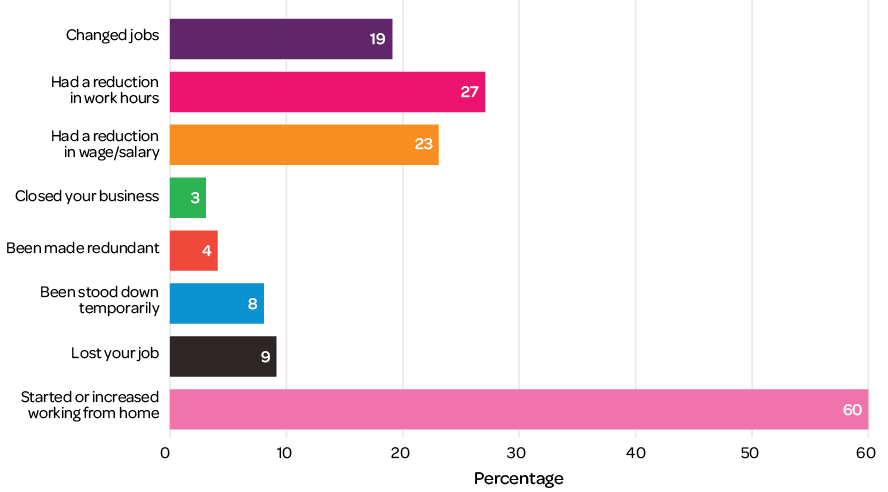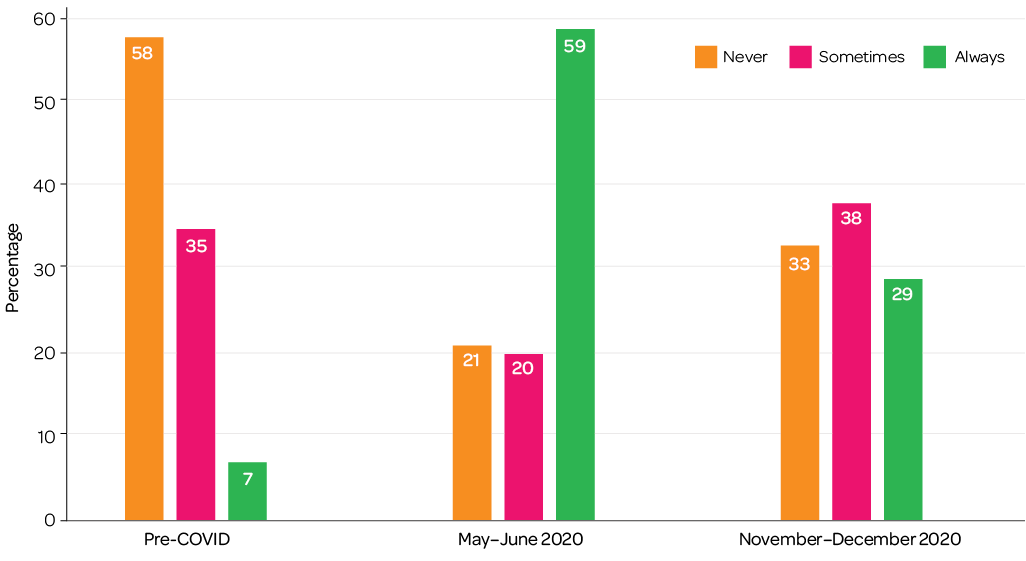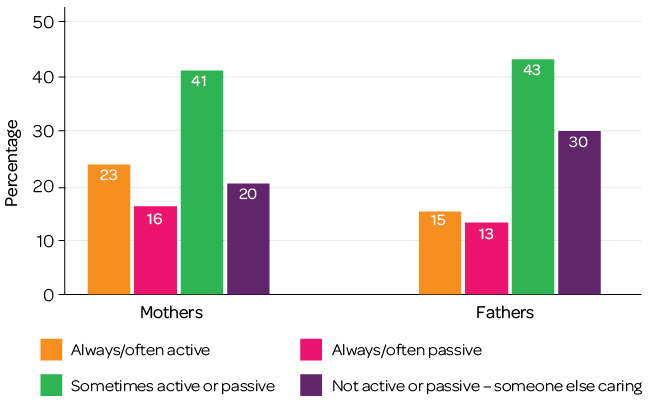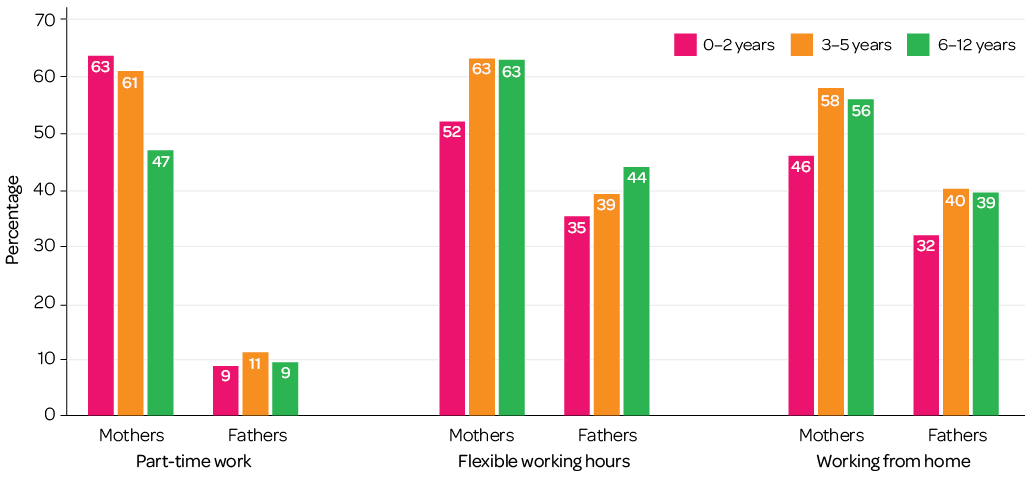Towards COVID normal: Employment & work-family balance
Families in Australia Survey report
June 2021
Jennifer Baxter, Diana Warren
Download Research report
Overview
The COVID-19 pandemic brought with it very significant changes for families in their participation in employment and experiences of work-family balance.
This report looks at families' experiences of work, including work-family balance, at the end of 2020, using the second survey of the AIFS Families in Australia (FIA) Survey series, conducted in November-December 2020, which included reports of changes over the year. The report also includes related findings from the first survey conducted in May-June 2020.
Key messages
-
Many survey respondents experienced unexpected changes to their or their partner's employment in 2020. One in 10 respondents said that they or their partner had lost their job and more than a quarter said that they or their partner had a reduction in working hours.
-
At November-December 2020, 67% of employed respondents said they or their partner sometimes or always worked from home. The proportion of respondents reporting that they or their partner never worked from home in November-December 2020 (33%) was considerably lower than the 58% before COVID.
-
Work-family balance continues to be a challenge, with the impacts of COVID adding to this in 2020. Working at home does not always facilitate better work-family balance. Those working at home and actively caring for children at the same time very often reported difficulties balancing their work and care responsibilities.
-
Mothers more often make use of particular work arrangements to help care for children. At November-December 2020, 57% of employed partnered mothers and 9% of employed partnered fathers used part-time work to help care for children. At this time it was fairly common for employed couple mothers and fathers to use flexible work (58% of mothers and 38% of fathers) and working at home (52% of mothers and 36% of fathers) to help care for children.
Employment changes in 2020
One way the COVID pandemic affected many families was in relation to employment, with restrictions linked to some job losses, and with others finding new employment opportunities. The effect of job losses was particularly apparent around the time of the first FIA Survey. For example, the Australian Bureau of Statistics (ABS) reported that an estimated 13.0 million people were employed in February and March 2020 in Australia but by April 2020 this had fallen to 12.4 million, in May 2020 it was 12.1 million and June 2020 was 12.4 million. At November 2020 an estimated 12.8 million people were employed.1
Also, the ABS showed that work hours were affected. They estimated that the number of employed people working fewer than their usual hours, or no hours at all (due to having no work, not enough work or being stood down), increased from 385,900 in February 2020 to a peak of 1,781,800 in April 2020, then declined steadily to 553,400 in February 2021 (167,500 higher than 12 months before).2
Many survey respondents experienced unexpected changes to their or their partner's employment in 2020 (Figure 1). Among respondents who were in the labour force (i.e. employed or seeking employment) or had a partner in the labour force:
- One in 10 (9%) respondents said that they or their partner had lost their job, and one in 12 (8%) said that they or their partner had been stood down temporarily.
- More than a quarter of respondents (27%) said that they or their partner had a reduction in working hours in 2020, and almost a quarter (23%) said they or their partner had a reduction in their wage or salary.
- Around one in five respondents (19%) said they or their partner had changed jobs in 2020.
Further to these changes, by far the most common employment change was an increase in working from home.
- Three in five respondents said they or their partner had increased the number of hours they worked from home or had started to work from home.
Figure 1: Employment changes experienced within families in 2020

Notes: Data relate to changes that were experienced by either the respondent or their partner. Restricted to respondents/partners who were in the labour force (employed or seeking employment) at the time of the second survey. N = 3,126.
The majority of respondents who experienced a change in their employment said that the change was a result of the impacts of COVID. The only exception was changing jobs, where only 30% said that this change was due to COVID.
I changed jobs partly due to the 'reality check' of COVID. It somehow gave me the courage to take a leap into the unknown, a heart decision rather than head decision.
Female, aged 39
Experiences of employment change varied somewhat between respondents depending on their characteristics. In particular, it was more likely for females to report starting or increasing working from home (54%), compared to men (36%).3 By age, the most likely to have started or increased working from home were those aged in their 40s or 50s, while it was younger and older people who were most likely to report having had a reduction in working hours.
Being a chef/pastry chef for 16 years, going from that to trying to survive on unemployment benefits has crushed any dreams about home ownership, travel, all I can hope for is a new kind of normal.
Male, aged 35
Both my husband and myself had hours reduced. My husband was then stood down but able to pick up some work. The stress of child care during this time was quite great when we had to work from home and raise our children while trying to hold down positions. Female, aged 36
Both my partner and I were considered 'essential workers'. I worked from home for a brief period (five weeks) during a lockdown in my area. However, my partner went to work every day.
Female, aged 43
The initial COVID outbreak required us to work from home full-time. However, even after restrictions eased we were able to continue working from home at least some days a week. This was a big change for my husband and he has welcomed the change. We changed our work arrangements from four long days to five shorter days, which allows us to drop and collect our kids from school, a short distance away. The COVID arrangements prompted us to make changes to our work arrangements, particularly for my husband, and our family has benefited as a result.
Female, aged 32
My brother and brother-in-law were both on JobKeeper near the beginning of the pandemic. My brother-in-law was very worried about being able to support my sister and their new child. He has since returned to normal hours but the two of them are also studying at the moment to find more secure long-term work.
Male, aged 24
Working from home
Changes in working from home can be seen in Figure 2, which draws on the first FIA Survey as well as the second survey. The first survey captured information on working from home before (early 2020) and during (May-June 2020) many of the COVID lockdowns. The second survey updates this to working from home arrangements at the end of 2020.4
- Pre-COVID, 7% reported that they or their partner always worked from home, and just over a third did some work from home.
- In May-June 2020, when restrictions were in place in many regions of Australia, more than half reported they or their partner were working only from home and 20% were doing some work from home.
- In November-December 2020, when restrictions had been eased in most states, almost 30% of respondents indicated that they or their partner were still working from home, and a further 38% were doing some work from home.
- The proportion of respondents reporting that they or their partner never worked from home in November-December 2020 (33%) was considerably lower than the 58% before COVID.
Figure 2: Percentages working from home in 2020, if employed

Note: Based on on information from respondent about changes in their own and their partner's employment.
As noted above, taking the individual rather than the couple perspective, it was more common for females to have increased or started working from home during the year.5 Gender differences were most apparent at May-June 2020, with differences less marked at the beginning and end of 2020.
For males:
- Before COVID, 59% never worked from home and 34% sometimes worked from home, while 7% always worked from home.
- At May-June 2020, 30% never worked from home, 22% sometimes worked from home, and 47% always worked from home.
- At November-December 2020, 36% never worked from home and 37% sometimes worked from home, while 27% always worked from home.
For females:
- Before COVID, 58% never worked from home and 35% sometimes worked from home, while 7% always worked from home.
- At May-June 2020, 19% never worked from home, 19% sometimes worked from home, and 62% always worked from home.
- At November-December 2020, 32% never worked from home and 39% sometimes worked from home, while 29% always worked from home.
We note that at the time of the second survey some states were still living with some COVID-related restrictions. In particular, the working from home proportions were much higher in November-December 2020 for Victoria (37% sometimes, 46% always) compared to other states (39% sometimes, 20% always).
During COVID we both worked at home but things have returned somewhat to normal here in the last three months and we have been working back in the office most of the time, unless we have a child unwell at home.
Female, aged 37
Have loved the flexibility of working from home and couldn't have survived the year without it due to child care, family duties and my own mental health. Miss the energy of the office and look forward to going back but will only go back a couple of days a week, and continue to work from home the other days.
Female, aged 41
Too much of a good thing! Working from home seemed like a great situation at first (noting that I did not have to home school a child - which sounded like a nightmare). But come the end of the year, feeling very isolated from my work, missing my workmates and seeing people face-to-face in meetings, etc., and sick of being in the same place every day. Also really need to control work-life balance - as work can spill over into my home life.
Female, aged 58
1 ABS, 2021, Labour Force, Australia March 2021.
2 ABS, 2021, Insights Into Hours Worked, February 2021, www.abs.gov.au/articles/insights-hours-worked-february-2021
3 These percentages are lower than the one for working at home in Figure 1, as Figure 1 is at the couple level - either the respondent or their partner having started or increased working at home.
4 In this analysis, adjustments have been made to account for the different characteristics of respondents at the time of the first survey versus the second survey. Characteristics that were taken into account were age, gender, education, state and region. These percentages reported are for those who were in paid employment at each time point.
5 These data are based on respondents' reports about their own working from home, or their partners, but reporting each based on the gender of respondent/partner rather than at the couple level.
Work-family balance: families with children
Balancing work and child care responsibilities is not always easy for parents, even aside from any COVID impacts. Then 2020 brought additional complications with the COVID restrictions, some periods of school closure, and restrictions on child care in some areas. Working from home posed challenges for parents who were managing this work while sometimes also caring for children.
Work-family balance and gender
At November-December 2020, focusing on parents with at least one child aged under 18 years, almost three in 10 respondents of the the second survey reported it was quite or very easy to combine paid work with child care responsibilities. At the other end of the scale, 46% reported that it was quite or very difficult to combine paid work with child care responsibilities.
- There are some gender differences, with 37% of males compared to 28% of females reporting their work-family balance was easy, and 38% of males compared to 46% of females reporting it was difficult.

To some extent gender differences reflect some different employment patterns:
- Fathers tend to have longer employment hours (38 hours per week for employed fathers compared to 27 hours for employed mothers).
- There are working from home differences, with the average number of work hours from home at November-December 2020 being 18 hours for employed fathers and 13 hours for employed mothers.
Work-family balance and working from home
Overall, there is not a strong association between working from home and experiences of work-family balance. Some jobs that involve working from home can readily be managed around care responsibilities, while the same is true for jobs that involve working elsewhere.
- Of parents that never work from home, 29% indicated it is easy to combine work and care responsibilities and 40% indicated it is difficult.
- Of parents that sometimes work from home, 29% indicated it is easy to combine work and care responsibilities and 48% indicated it is difficult.
- Of parents that always work from home, 30% indicated it is easy to combine work and care responsibilities and 49% indicated it is difficult.
Among parents that are working from home, the way that work and care is managed continues to show that parents are doing some care while working - although at much lesser rates than were observed in the the first survey data. We asked parents how often they were actively or passively caring for children while working, with 'active' described as meaning children were likely to be often needing or asking for help or input to what they were doing. Among working-from-home parents with at least one child aged under 13 years:
- 22% were always or often actively caring for children while working (compared to 40% reported in the first survey)
- 15% were always or often passively caring for children while working (compared to 28% in the first survey)
- 41% were sometimes actively or passively caring for children while working (compared to 21% in the first survey)
- 21% were rarely or never caring for children while working - someone else was caring for them (compared to 11% in the first survey).
Rates of caring while working varies by age of youngest child. There is more active caring for under-school-age children, although there is also a higher likelihood of not caring for the youngest children while working because someone else was caring for them (35% for 0-2 year olds).
Figure 3: Home care for children under 13 years. Types of care used while working from home, by age of child

Gender differences were also apparent with mothers more often actively caring for children while working (23%) compared to fathers (15%).
Figure 4: Home care for children under 13 years. Types of care used while working from home, by gender of parent

The degree of difficulty of combining paid work with caring, among those working at home, was related to these reports of how care was combined with work. In particular, among those always or often actively caring for children while working, 74% said it was difficult to combine work and family, and 11% said it was easy.
Work arrangements used to care for children
Couple parents with children aged under 13 years were asked what work arrangements they used to help care for children.6
Figure 5 shows the gendered patterns, with part-time work remaining a common approach for mothers but not fathers. However, significant proportions of mothers and fathers use flexible working hours and working from home to help manage the care of children. Overall, 12% of employed mothers did not use any particular work arrangements to help care for children, compared to 38% for fathers.
Figure 5: Employed mothers' and fathers' work arrangements used to care for children

Note: These data are based on reports of respondents about their own and their partner/spouse's work arrangements.
The silver lining of COVID has been the increased acceptance of working from home - particularly for men. With the whole office forced to utilise inclusive meeting practices (such as video meetings), the use of flexible working arrangements and attitudes towards them has moved. They are no longer just seen as the 'mummy track' and the more men and people without children use them, the less of a career cost they will hold for working parents and women in particular.
Female, aged 38
My work finally allowed flexible work arrangements - as a mother, I have been asking for this for a long time.
Female, aged 47
I have enjoyed working from home this year. I have found I am more efficient with my work and less distracted, and have enjoyed the freedom to be more flexible with my hours. I have, however, found it hard not to meet face-to-face with my work colleagues (although we have phone meetings, it's just not the same).
Female, aged 43
Focusing on the three most commonly used work arrangements, Figure 6 shows that among mothers, part-time work is more commonly used when there are younger children in the family, while mothers and fathers are more likely to use flexible work hours and working from home when the youngest child is aged at least three years old, compared to 0-2 years.
Figure 6: Employed mothers' and fathers' selected work arrangements used to care for children by age of youngest child

Note: These data are based on reports of respondents about their own and their partner/spouse's work arrangements.
These gender differences are also apparent in some of the comments about how work and care and household tasks are managed within couples.
My husband's work is not flexible to allow for him to be home more. He works for a small business and is an apprentice so asking for flexible finish times is not an option.
Female, aged 33
I wish my husband's work was more flexible so we could share the caring responsibilities. Our jobs are as demanding as each other's but as mine is very flexible it puts the caring responsibilities on me.
Female, aged 43
The need to use various flexible work arrangements or working from home is linked to families' child care options.
When returning to face-to-face work I need flexible arrangements as some of my work may be on the weekend when formal child care is not available.
Female, aged 53
As a shift worker I need hours that are more flexible or child care with more flexible hours. At this stage I am restricted to work on my partner's days off and only specific shifts due to inaccessible child care hours and inability to be supported by family to assist in child care.
Female, aged 37
6 A problem with the data collection instrument led to these data not being available for single parents. This will be rectified for future data collections.
About the survey
Towards COVID Normal was the second survey in the Families in Australia Survey (AIFS' flagship survey series). It ran from 19 November to 23 December 2020, when restrictions had been eased in most states.
The pandemic in Australia triggered an unprecedented set of government responses, including the closing of Australia's borders to non-residents, and restrictions on movement, gatherings and 'non-essential' services.
Although the health consequences over the period were not as severe in Australia as they were in many countries, social and economic effects were profound. The Towards COVID Normal survey attempted to capture some of those effects. The survey was promoted through the media, social media, newsletters, internet advertising and word of mouth.
Survey participants
- In the first survey, there were 7,306 respondents to the survey, of which 6,435 completed all survey questions.
- In the second survey, 4,866 participants responded, of which 3,627 completed all survey questions.
Media releases
Credits
Authors: Jennifer Baxter and Diana Warren
Editor: Katharine Day
Graphic design: Lisa Carroll
Featured image: © GettyImages/Kerkez
Baxter, J. & Warren, D. (2021). Towards COVID normal: Employment & work-family balance in 2020. (Families in Australia Survey report). Melbourne: Australian Institute of Family Studies.